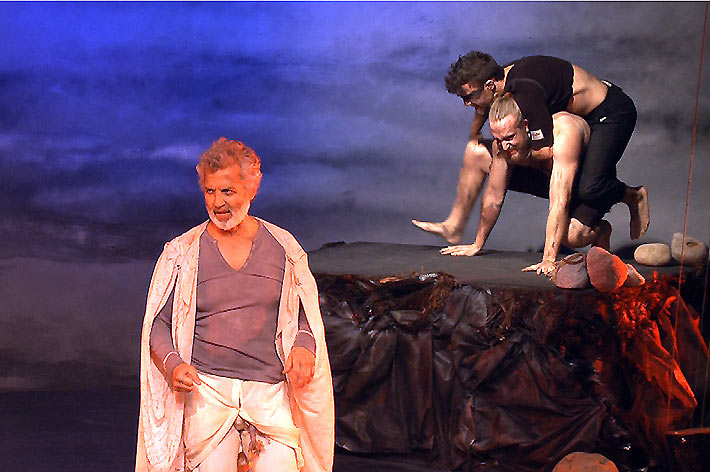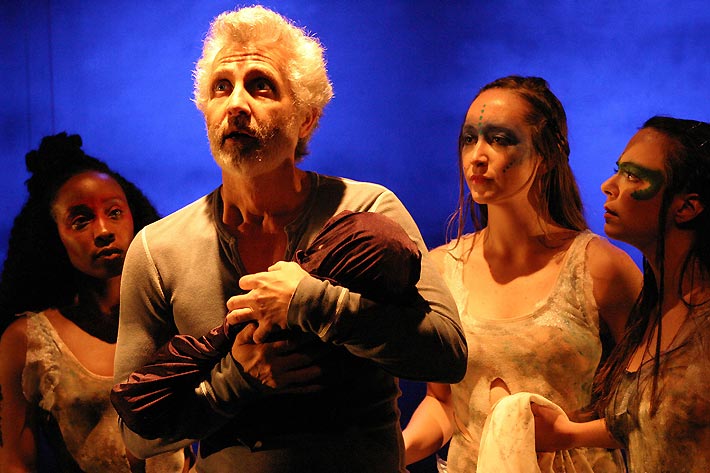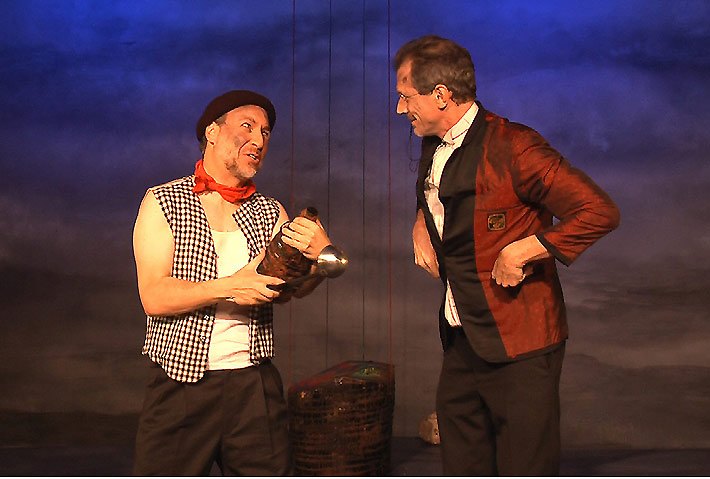John Farmanesh-Bocca has in the past impressed me.
Now he’s pissed me off.
Though, I am still impressed.
A number of years back Farmanesh-Bocca first entered my consciousness with his staging of Ellen McLaughlin’s Ajax in Iraq at the Miles Playhouse in Santa Monica by his Not Man Apart Physical Theatre Ensemble.
Ajax in Iraq was a powerful and stunning layering of military cadence, dance, music and a cornucopia of theatrics, blending current events of the Iraq war with the myths of Troy, which served to scream out the truth we all know yet are resolved to remain deaf to; “War is a madness.”
With Tempest Redux at the Odyssey Theatre Ensemble, co-produced with The New American Theatre, Farmanesh-Bocca has re-entered my consciousness again and I hope I can get him out.
The Tempest is thought to be the last play of Shakespeare’s, or at least the last play that he penned alone.
It is an odd work for Shakespeare.
It is much neater than his other great works; neater in the sense of having a single central story which he doesn’t contrast in mirroring subplots.
In Hamlet you have Hamlet, Fortinbras, Laertes.
In Lear you have Cordelia and her sisters; Gloucester and his sons.
In The Tempest you have, solely, Prospero.
In fact, it is his only play where there is an attempt to observe the classical “unities” of Greek theatre: unity of time, of place, of story.
And in The Tempest, fittingly if it was indeed Shakespeare’s “last” play, you have what amounts to echoes of his “greatest hits.”
You have a father in danger of losing his daughter (Lear), a father who has married his daughter to an African (Othello), a plot to murder a king (Macbeth), a son mourning his dead father (Hamlet), mortals being tormented by magical creatures (Midsummer Night’s Dreams), a noble manipulating all the action from behind the scenes (Measure for Measure).
Of interest, is that Shakespeare’s two favorite tricks of the trade are missing from The Tempest; the “play within a play” and the cross dressing heroine. †
If we include masques among the count of “the plays within a play,” then those two devices are found in nearly half of Shakespeare’s works.
Not The Tempest however, as if Shakespeare wanted it to stand out from the rest of his works.
Originally it was not a popular play, nor judged to be of any particular merit. That standing began to change in the mid 19th century, and today The Tempest is not only his most produced play, but is considered one of his greatest.
Though I may be wrong on this, I cannot imagine that any other Shakespearean play has inspired such a vast multitude of artists and creators in so many diverse fields: The Tempest has found its way into the art and onto the canvases of Henry Fuseli, Richard Dadd, John Mortimer, George Romney, Henry Singleton, James Ward, William Hogarth, Neil Gaiman and Johann Heinrich Ramberg; It’s in the literature of Dan Simmons, Robert Browning, Aimé Césaire, Ngũgĩ wa Thiong’o and Shelley; It’s served as source or inspiration for half a hundred operas, and numerous other musical tributes by such talents as Arthur Sullivan, Engelbert Humperdinck, Marianne Faithfull, Tchaikovsky, Hector Berlioz, Pete Seeger and others.
The Tempest holds the distinction of being the most musical of Shakespeare’s plays, and Farmanesh-Bocca adapts his staging to this fact, and it seems there’s not one moment of his production not supported or underscored by music, managing to convey a satirical tone with some of his choices, while achieving a jarring juxtaposition with others.
There is some indication Shakespeare himself took to the boards to play Prospero, the exiled Duke of Milan who, after using his power to reclaim his kingdom, renounces his magic and returns to the land of his birth where every third thought will be of his death.
Whether that story has any validity to it, it has intrigued the talent that has been drawn to the various roles: Prospero has been played by Maurice Evans, John Gielgud (who claimed it was his favorite role), Christopher Plummer, John Cassavetes, Yukio Ninagawa, Helen Mirren, Walter Pidgeon (in the sci-fi Forbidden Planet), Herbert Beerbohm Tree, Laurence Olivier, Minoru Fujita (in a Bunraku puppet version), Michael Hordern, Max Von Sydow, Vanessa Redgrave, Peter Fonda (as a Southern slave-owning Prospero); Caliban by Richard Burton, Canada Lee, James Earl Jones, Raul Julia; Miranda by Lee Remick, Molly Ringwald, Anne Francis; Ariel by Roddy McDowall, Susan Sarandon and Robbie the Robot.
A William Wellman Western (Yellow Sky), a Disney feature, A Cirque du Soleil touring production, a graphic novel, ballets, a Japanese Noh play, even the name for a prestigious quarterly journal that covers “post-colonial states”; all these The Tempest has inspired.
Now it’s inspired John Farmanesh-Bocca and The New American Theatre.
Jack Stehlin as Prospero is at his best since Tartuffe.
The magical spirit Ariel is performed here by three actresses (Shea Donovan, Briana Price and Emily Yetter) and is voiced by a fourth (Brenda Strong) a conceit that Farmanesh-Bocca puts to interesting use.
Most of the cast is assigned double and triple duty meeting the demands placed upon them commendably.
Dennis Gersten, an actor of skill and intelligence, never disappoints and certainly doesn’t here in the roles of Prospero’s villainous brother Antonio.
As Alonso the King of Naples, Gildart Jackson does a more than respectable job, but when he assumes the comic role of the drunken butler Stephano and Gersten that of the drunken cook Trinculo, the evening sees its finest performances, as together they light up the stage.
Their scenes were familiar to most of those in the audience; who were thoroughly delighted to see them so well handled.
But it was used as a deception on Farmanesh-Bocca’s part, to lull the audience into a comfortable state, enticing us to drop our guard if even slightly.
None of us suspected the body blow to come.
To Dash Pepin and Willem Long, falls the most daunting task of rendering Caliban, the island’s lusting monster, in a co-jointed performance. It is a challenge they more than meet.
Their portioned performances combine the muscular and sensual, while simultaneously radiating a tortured sense of being. Slithering in serpentine fashion about, around, over and under each other, the actors appear in a constant metamorphic state, either as cells tearing asunder in fission or as Dante’s inhabitants of Hell in wretched whorls as the sins are burnt off them. It is nearly impossible to take your eyes off them.

Jack Stehlin as Prospero, Dash Pepin (bottom) and Willem Long (top) as Caliban – Photo by Jeannine Wisnosky Stehlin
Overall the casting is more capable than dazzling, but succeeds in finding moments that shimmer hues of brilliance. But, leaving this production, what you will carry away with you is the art and craft of John Farmanesh-Bocca.
He has not so much directed this production as choreographed and sculpted it.
In chiseling and chipping away much of the dialogue he has eliminated the need for an intermission. The appearance of Juno, Iris and Ceres, he’s replaced with a filmed montage that brought to mind the Suicide Parlors in Soylent Green.
Farmanesh-Bocca has not limited his restructuring to only the physical aspects of The Tempest, but selects to extend it downward into the very soul of the play. There his reflection becomes a reinquiry, reilluminating, revitalizing and lastly reinvention of the original.
Drawing from Ambrose Bierce’s An Occurrence at Owl Creek Bridge (1890), Rudyard Kipling’s The Man Who Would Be King (1888), even Terry Gilliam’s Brazil (1985) Farmanesh-Bocca has given us a dark and disturbing Tempest, one in which the storm is not calmed by love nor ended thru magic, but comes as death’s conclusion.
Shakespeare was a master at openings – a ghost stalking over battlements, witches gathered on a site drenched in slaughter, a ship tempest tossed.
Farmanesh-Bocca has provided The Tempest with a potent, powerful ending, a variation of an ancient Jewish custom, the B’er Heitev, the ultimate act of respect that one can show for another with the placing of stone or pebble.
The ending he’s chosen is not one that rings of falsehood, revealing Farmanesh-Bocca’s respect for Shakespeare and for Prospero, nor are we jarred by its artificiality or dishonesty; and in this he shows his respect for the audience.
Farmanesh-Bocca is an artist of remarkable talent whose work should be seen and whose name should be remembered.
Tempest Redux is an experience that must be braved by some and one that will prove unsettling for others. Nevertheless, it is also an experience that none should miss.
This world holds, I know, dark crevices wherein suffering lurks, and this awareness undoubtedly fuels in me the somewhat adolescent need for “happy endings.”
But The Tempest deserves its happy ending as Prospero does his, and Shakespeare his.
We all deserve a happy ending.
And perhaps by peering into those crevices is how Farmanesh-Bocca believes we earn them.
† (The current school of thought is of the mind that the “Goddess masque” seen in the fourth act was an addition made after Shakespeare’s death when the play was staged at a royal wedding.)
♦ ♦ ♦
Odyssey Theatre Ensemble and The New American Theatre presents:
Tempest Redux by William Shakespeare
Conceived, choreographed and directed by John Farmanesh-Bocca
Starring Jack Stehlin (Weeds) as Prospero.
Also Starring Mimi Davila, Shea Donovan, Dennis Gersten,
Gildart Jackson, Willem Long, Charles Hunter Paul,
Dash Pepin, Briana Price, Jack Stehlin and Emily Yetter
Produced by Ron Sossi and Jeannine Wisnosky Stehlin
Show Runs — Feb. 20 – April 10:
• Wednesdays at 8 p.m.: March 9* and March 30 ONLY
• Thursdays at 8 p.m.: March 3, March 17, March 24 and April 7 ONLY
• Fridays at 8 p.m.: Feb. 26; March 4, 11, 18**, 25; April 1*, 8
• Saturdays at 8 p.m.: Feb. 20 (opening), 27; March 5, 12, 19, 26; April 2, 9
• Sundays at 2 p.m.: Feb. 28; March 6, 13, 20*, 27; April 3, 10 (no 2 p.m. matinee on Feb. 21)
• Sunday at 5 p.m.: Feb. 21 ONLY
*Post-show discussions take place on Wednesday, March 9; Sunday, March 20; and Friday, April 1,
**The third Friday of every month is wine night at the Odyssey:
enjoy complimentary wine and snacks and mingle with the cast after the show.
WHERE:
Odyssey Theatre
2055 S. Sepulveda Blvd.
Los Angeles CA 90025
For Tickets and Additional Information:
• (310) 477-2055 ext. 2 or www.OdysseyTheatre.com







